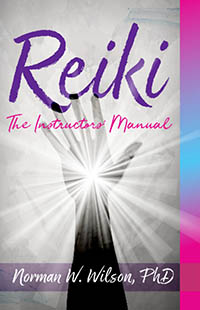
EXTRACT FOR
Reiki Instructors' Manuals
(Norman W. Wilson)
FIRST MANUAL
LEVEL ONE
ATTUNEMENT ONE
CHAPTER ONE
INTRODUCTION: Reiki (pronounced ray-kee) is a
natural healing system based upon the flow of universal energy. Rei means
universal and ki means life force. The concept is as old as is humanity. It is a
laying-on-of hands technique somewhat modified from its earlier religious
usage. My first experience with the latter approach was back in the early 1940's. A young girl was very ill and all
medical attempts to help her failed. The local priest called for a Healing. He
asked that those who were pure of heart in their desire to help this little
girl come to the church, join hands in a long line. The first person in that
line held his hand out to the priest, who in turn placed his hand on the little
girl's head. She got well. People called
it a wonder, a metaphysical experience in today's terms. In our modern world,
we understand the transfer and redirection of energy. Solar panels absorb the
light of the sun and convert it into electricity. Reiki is based on several healing modalities grounded in
Asia, especially Chinese and Japanese
medicines. Fast forward to the 20th Century, specifically, the
1920's. It was during this time period that the use of energy to help to heal was, you might say, rediscovered. Dr.
Mikao Usui a Japanese doctor came to this approach after spending time in a Zen
monastery. Taking what he understood, he applied it to his practice and began
to train others. Two others have had a significant
influence on its development and
recognition: Dr. Cjikorp Hayashi and Mrs. Hawayo Takata. Dr. Hayashi opened a healing clinic in Tokyo and is
responsible for developing a set of complex hand positions to be used during a healing session. Hawayo Takata is
given credit for bringing Reiki to Hawaii, and then to mainland United States,
to Canada and finally to Europe. As is all too often the case, when one enjoys
success with a partner, there is a split.
In 1980 two splintered groups were formed, the Reiki Alliance and the
American International Reiki Association, Inc. Divergent View: I want to stop
here for a moment and express a couple of my own opinions. In much of the
literature surrounding Reiki the following term is used; Reiki Universal Energy.
If my understanding is correct Reiki really means universal energy (Life
force). So why say Energy, Energy when talking about Reiki? Why not simply say
Reiki or Universal Energy? Second, I want to address, early on, the issue of hands-on
treatment. I do not recommend physically
touching a client unless there is a written statement you, as a healer, may do so. And then, I strongly urge
stating which body parts may be touched: shoulders, back of neck, front, back and top of head, and feet. I suggest
hovering hands over chest and abdomen. Some Reiki practitioners do not
physically touch a client's body and others do. It a caution for today's world
of sexual harassment. Third, I do not recommend clients remove their clothing.
I do ask them to remove their shoes and socks before getting on the treatment
table. I use essential oils in my Reiki treatment and I begin with the feet.
More about feet later. Some Concerns: Often beginning
Reiki practitioners worry about what treating others does to them. Giving Reiki
does not diminish your energy. You, as a
Reiki Practitioner, do not generate the energy. It flows through you, much as
does an electrical current flow through a wire. You are a CONDUIT. As a Reiki Practitioner,
you have to be aware of the potential of picking up negative energy from a client.
Such energy exudes throughout the treatment room and may linger. Cleans the
room after use, wash your own hands, give yourself a spritz of lavender
hydrosol, and change the massage table covering. If you use a light blanket to
cover the client, change that as you receive a new client. Payment and what to charge may be an issue for some.
Traditional Reiki says charge otherwise your gift will not be really
appreciated; thus, the result may not be as hoped for. This does not mean you
can't gift someone. Sometimes, as a Reiki Practitioner,
you may have a client who is in need of spiritual healing. Reiki can help.
However, if the issue is emotional you need to anticipate crying, other
emotional outbursts, or a rejection. A nearby box of tissues is always a good
idea. Soft music playing in the background is generally accepted. During your healing session do not carry on a running
conversation. Check to see if the client is comfortable. HOW
REIKI WORKS: Most of the literature refers to Reiki as "life force" or
"Universal Life Force Energy." For me, such statements do not tell me
very much. I prefer using vibration or universal vibration. My reason for this
is simple: Everything vibrates. Vibration creates energy. Humans, plants, animals,
rocks, water, air, dirt all vibrate. Some Reiki Practitioners
believe energy flows through their hands but is not generated by them.
For me, that flies in the face of scientific evidence
that all things vibrate. You vibrate and as a healer, you use your natural vibration to merge with the vibrations
of the universe and then redirect the flow of energy
to where it is needed in a client's body. Think in terms of a tuning
fork. Once it is struck, it vibrates at a certain speed or hertz. You feel that
vibration. Different tuning forks have different vibrational frequencies. You
change your vibrational frequencies as directed by those of your client's body.
And therein lies a secret to Reiki Healing's success. |

